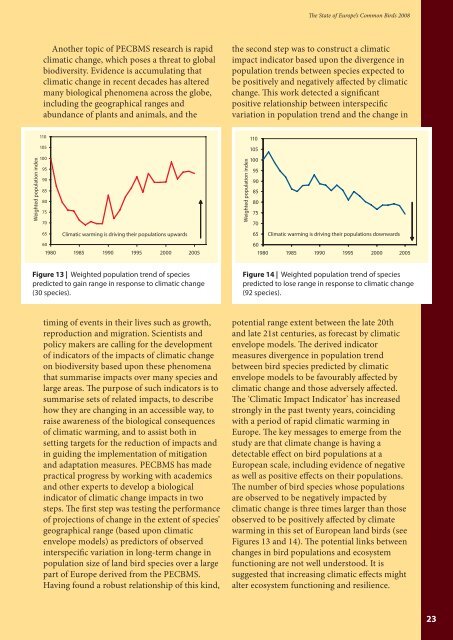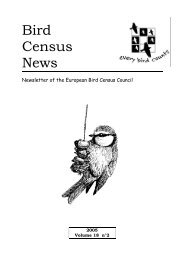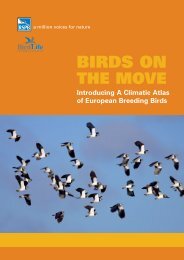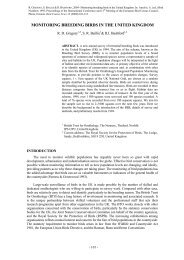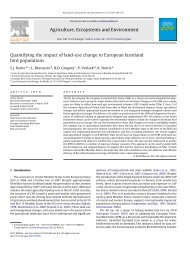The State of Europe's Common Birds 2008 - European Bird Census ...
The State of Europe's Common Birds 2008 - European Bird Census ...
The State of Europe's Common Birds 2008 - European Bird Census ...
You also want an ePaper? Increase the reach of your titles
YUMPU automatically turns print PDFs into web optimized ePapers that Google loves.
<strong>The</strong> <strong>State</strong> <strong>of</strong> Europe’s <strong>Common</strong> <strong><strong>Bird</strong>s</strong> <strong>2008</strong>Another topic <strong>of</strong> PECBMS research is rapidclimatic change, which poses a threat to globalbiodiversity. Evidence is accumulating thatclimatic change in recent decades has alteredmany biological phenomena across the globe,including the geographical ranges andabundance <strong>of</strong> plants and animals, and thethe second step was to construct a climaticimpact indicator based upon the divergence inpopulation trends between species expected tobe positively and negatively affected by climaticchange. This work detected a significantpositive relationship between interspecificvariation in population trend and the change inFigure 13 | Weighted population trend <strong>of</strong> speciespredicted to gain range in response to climatic change(30 species).Figure 14 | Weighted population trend <strong>of</strong> speciespredicted to lose range in response to climatic change(92 species).timing <strong>of</strong> events in their lives such as growth,reproduction and migration. Scientists andpolicy makers are calling for the development<strong>of</strong> indicators <strong>of</strong> the impacts <strong>of</strong> climatic changeon biodiversity based upon these phenomenathat summarise impacts over many species andlarge areas. <strong>The</strong> purpose <strong>of</strong> such indicators is tosummarise sets <strong>of</strong> related impacts, to describehow they are changing in an accessible way, toraise awareness <strong>of</strong> the biological consequences<strong>of</strong> climatic warming, and to assist both insetting targets for the reduction <strong>of</strong> impacts andin guiding the implementation <strong>of</strong> mitigationand adaptation measures. PECBMS has madepractical progress by working with academicsand other experts to develop a biologicalindicator <strong>of</strong> climatic change impacts in twosteps. <strong>The</strong> first step was testing the performance<strong>of</strong> projections <strong>of</strong> change in the extent <strong>of</strong> species’geographical range (based upon climaticenvelope models) as predictors <strong>of</strong> observedinterspecific variation in long-term change inpopulation size <strong>of</strong> land bird species over a largepart <strong>of</strong> Europe derived from the PECBMS.Having found a robust relationship <strong>of</strong> this kind,potential range extent between the late 20thand late 21st centuries, as forecast by climaticenvelope models. <strong>The</strong> derived indicatormeasures divergence in population trendbetween bird species predicted by climaticenvelope models to be favourably affected byclimatic change and those adversely affected.<strong>The</strong> ‘Climatic Impact Indicator’ has increasedstrongly in the past twenty years, coincidingwith a period <strong>of</strong> rapid climatic warming inEurope. <strong>The</strong> key messages to emerge from thestudy are that climate change is having adetectable effect on bird populations at a<strong>European</strong> scale, including evidence <strong>of</strong> negativeas well as positive effects on their populations.<strong>The</strong> number <strong>of</strong> bird species whose populationsare observed to be negatively impacted byclimatic change is three times larger than thoseobserved to be positively affected by climatewarming in this set <strong>of</strong> <strong>European</strong> land birds (seeFigures 13 and 14). <strong>The</strong> potential links betweenchanges in bird populations and ecosystemfunctioning are not well understood. It issuggested that increasing climatic effects mightalter ecosystem functioning and resilience.23


